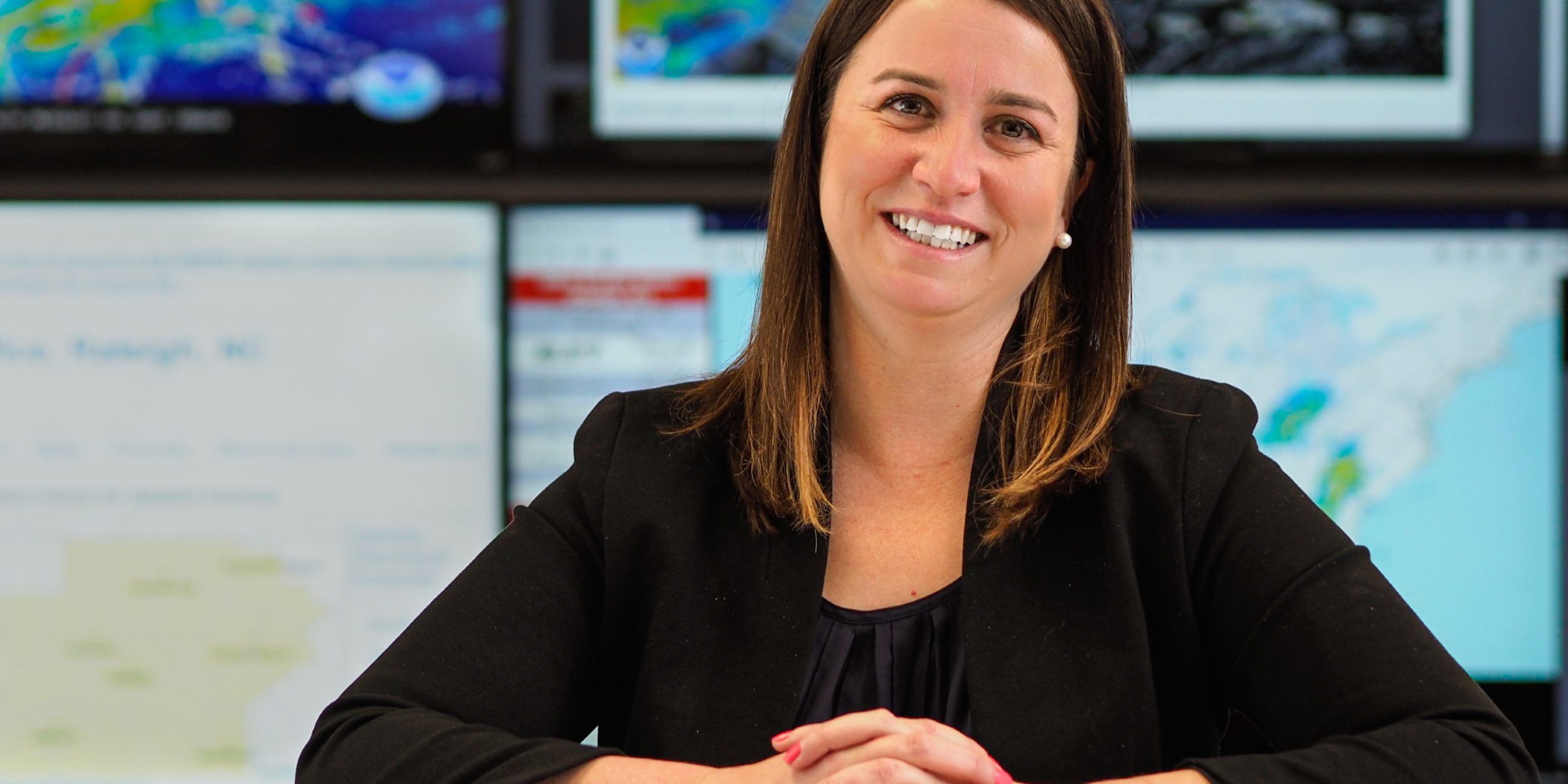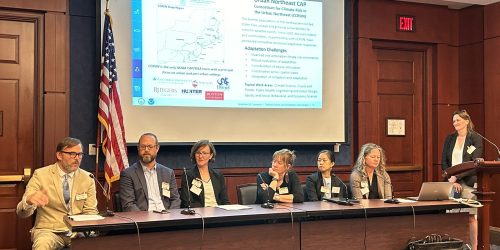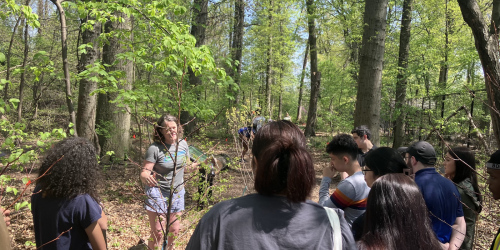Women’s History Month 2022


This article kicks off a series of interviews with NOAA Climate Program Office (CPO) employees and CPO-funded scientists in celebration of Women’s History Month. CPO communications specialist John Dos Passos Coggin conducted the interview.
Kathie Dello is the state climatologist of North Carolina and the director of the North Carolina State Climate Office (NCSCO). She is the 5th permanent director and first woman to hold this position at the NCSCO in the office’s history.
Kathie also serves as the co-director of the NOAA Regional Integrated Sciences and Assessment (RISA) for the Carolinas, the Carolinas Collaborative on Climate, Health, and Equity (C3HE). The RISAs are housed in CPO. The C3HE team will build upon years of regional work on climate science, tools and assessments to move into a new phase that centers Justice, Equity, Diversity, and Inclusion (JEDI) principles at the forefront of NOAA-funded climate research and to deliver climate futures to more communities than have been previously served.
She has a Ph.D. in Environmental Sciences from Oregon State University, a Master’s in Geography and a Bachelor’s in Atmospheric Science from the State University of New York at Albany.
Our conversation follows.
On Monday, February 28th, the United Nations Intergovernmental Panel on Climate Change released the second part of its Sixth Assessment Report. Some 270 top scientists from 67 countries, including two NOAA scientists, produced the report. What are your thoughts on its findings?
Each IPCC report that comes out has a stronger, more dire message. Time is running out. This report is really impressive. It really dug into adaptation and local impacts. From what I’ve seen so far, they did a really nice job.
Did becoming the first woman director of the North Carolina State Climate Office change the way you think about the significance of recruiting and supporting women in the climate science workplace?
Absolutely. I feel very lucky to work with a lot of women in the climate space. In North Carolina especially, our chief resilience officer for the state, Amanda Martin, is a colleague that I enjoy working with. One of the things I’m really proud of is that we have a state weather network, the North Carolina ECONet, and half of the staff on that are women. And I think that’s rare for most states—it tends to be a job that men occupy.
What are your duties and priorities for the position of co-director of the NOAA Regional Integrated Sciences and Assessment (RISA) for North and South Carolina?
We submitted a proposal to RISA in early 2021. It was summer 2020, we knew that the Carolinas RISA was going to go up for bid in the next few months. We were a few months into a global pandemic and there was this big racial reckoning and social uprising. It became very obvious to us that you couldn’t just silo climate and climate resilience. That health and equity were inextricably tied to it. So, we thought why not put in a proposal for the RISA that demonstrates our commitment to all of those things as climate resilience.
We also strove to put together a really diverse team. One of my co-leads, Jennifer Runkle, is a really talented epidemiologist. We have HBCUs in North and South Carolina. Our team is mostly women including a number of women of color.
You were a lead author for the 2020 North Carolina Climate Science Report. The report had a 5-page Plain Language Summary. What were your best practices for creating that summary? What is the greatest challenge of distilling science to plain language?
I pushed for writing the Plain Language Summary. When I worked in Oregon, we had a state climate assessment mandated by the legislature, and I led the first one. But the legislature only wanted us to submit a two-page summary out of the approximately four hundred pages in the report. So, I had practice in crafting summaries for the general public or a decisionmaker audience.
I think writing plain language requires many iterations. It requires lots of feedback from people outside the process. It requires writing the way you’d talk to your non-specialist neighbor, or friend at a coffee shop. When you’re integrated in writing these, you can get caught up in the jargon.
Given the popularity of North Carolina’s Outer Banks as a tourist destination, it seems sea level rise and hurricane receive the most media attention during discussions of climate risk for the state. What other significant climate risks for the state should the public know about?
We do talk a lot about flooding statewide. Whether from hurricanes that hit the Gulf or North Carolina’s coast. I’m thinking back to Tropical Storm Fred last August, which was a Gulf storm. It passed through the North Carolina mountains as a tropical storm and caused fatal flooding in Haywood County, which is just west of Asheville. Some of the worst flooding that the area had ever seen before.
We’re also talking about nighttime heat a lot. We’ve seen our overnight temperatures spike, which is a public health risk and a risk for agriculture.
You’ve mentioned in a previous interview that your State Climate Office often works with agriculture. What are some of the significant climate risks faced by that sector in North Carolina? What is being done to build resilience in that sector?
We’re fortunate to be a land grant university with a robust and well-funded extension service tied to it. So, NC Extension funds half a position in our office just to work with their program. That’s my colleague Rebecca Ward who is an assistant state climatologist and also a great woman in science.
We talk about risks like flooding. It impacts our marquee crop—sweet potatoes (Since 1971, North Carolina has ranked as the No. 1 sweet potato producing state in the U.S. Its hot, moist climate and rich, fertile soil are ideal for cultivating sweet potatoes, averaging at nearly 60% of the U.S. supply). If your fields are flooded, you can’t get them in. We also talk about drought. We see flash droughts in North Carolina. We had a big drought in 2007. We have extremes in both wetness and dryness in this state.
We create tools for farmers to use to understand how many growing degree days have accumulated for corn and other crops. We also study the impact of warming temperatures on invasive species that could harm our agriculture.
Other important agricultural sectors are hogs, dairy cows, and Christmas trees.
You earned your PhD at Oregon State University and spent about a decade in Oregon studying climate and working in the climate sector before moving to North Carolina. These seem like very different states. Were there consistent skills and principles that transferred with you and made that transition easier?
In Oregon it was snowpack and drought and wildfire, and I took off to a place where flooding and hurricanes were paramount. That said, it was really fascinating to observe the heat wave in Oregon last summer. Those were temperatures I thought were physically impossible in 2021. Oregon has extreme heat challenges as well.
The specific impacts change between Oregon and North Carolina but there’s still a lot of similarities. We have mountains that influence the climate. We have a robust coastline—sea level rise issues in both states.
In 2018, you co-authored an article in the journal Ecological Processes on Indigenous knowledge of climate change. What have you learned over the years about Indigenous peoples’ knowledge of sustainability, natural resources, and climate?
I learned so much through that article. The lead author, Samantha Chisholm Hatfield, taught me a lot about not centering Western science in everything and working with Indigenous scholars. That the lived experiences, stories, and values that are held by Indigenous populations are so incredibly important. Western science is not more meaningful or important than that.
Your office supported the 2021 NOAA-funded urban heat island campaign in Raleigh and Durham. What did you learn from that experience?
That was a really fun and interesting project. We learned a lot. We had five hundred volunteers sign up to cover Raleigh and Durham. We engaged them throughout the year, leading up to the summer. We actually had a pretty cool start to the summer in June and July, so we watched the forecast for a while and volunteers were becoming impatient for the mapping to begin.
So, we saw a 90-degree day in the forecast. It was a Friday. We thought we could have our campaign that day. Then the western wildfires happened and we got wildfire smoke out here in North Carolina, which could keep our temperatures a few degrees cooler than expected. So, a few days before, we’re looking at the sky and the forecast thinking ninety degrees is probably out of the question. We had to decide if we wanted to go for a perfect hot day and risk losing volunteers during the wait, or do we go forward on an 88-degree day and keep these engaged people together. We decided to have the mapping campaign. So, now we have these people who are really invested in heat mitigation in both Raleigh and Durham.
So, I learned that. That not everything is going to be perfect, but when you can get citizens engaged in science, that’s pretty cool. However you can do that, take that opportunity. Also, it was a really important lesson in how we’re all living on one planet – that something happening in the western US could impact our weather out here in North Carolina.
Do most North Carolina residents have air conditioning? Is there an environmental justice issue there?
There is air conditioning, but lower-income residents might not have it or they might not turn it on because it’s expensive. We see this with farm workers. They live in housing that may not have AC and they’re working outside all day, too, so they’re already stressed when they go to sleep at night. It is a big equity issue. I also think it’s probably one of our most solvable climate challenges.
What does celebrating Women’s History Month mean to you?
I think it means honoring the people who came before us in really challenging conditions to be a woman in science or a woman in policy, and being grateful for their contributions and their perseverance.
I think it also means celebrating my colleagues who are women in science. I’m really fortunate to work with wonderful people who teach me every day and hold me accountable.
I also think it’s recognizing that the path for women in science is difficult. We talk about a pipeline but I read an article by some colleagues a couple months ago that show the path for women is more like an obstacle course. Women are thrown a number of challenges in their career and the data shows that we lose them as they progress in their careers.
As we see women progress in their careers, it gets more challenging. Childcare issues. Structural inequities in academia. Bullying and sexual harassment. These are things that chase women out of science.
We also need to support Black, Indigenous, and women of color in the sciences. White women have a lot of privilege in this field and in science and we need to help everyone along.
COVID gave us a few good lessons. One was bringing conferences online, allowing a lot of mothers to access conferences that they couldn’t access in the past. If they had a newborn child and didn’t have childcare, then they couldn’t attend. We’re seeing some things improve.
Can you name some women in the climate science field whom you look up to?
Jane Lubchenco, who is currently Deputy Director for Climate and Environment at White House Office of Science and Technology Policy and formerly NOAA Administrator.
Marine geologist Dawn Wright, who is Chief Scientist at Esri and Professor of Geography and Oceanography in the College of Earth, Ocean, and Atmospheric Sciences at Oregon State University.
Jamila Simpson, who is now North Carolina State University’s first assistant dean for inclusive excellence. She was also the first black woman to earn a meteorology degree from NC State. I work with her now on a pretty frequent basis. I look up to her.









